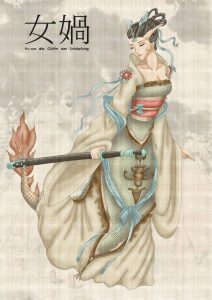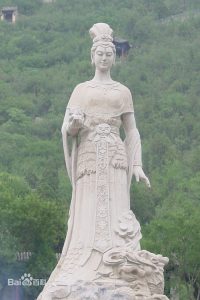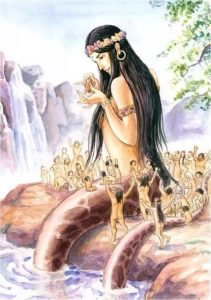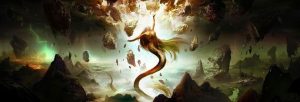1 Goddess Nüwa
Ricky Wang
Key Terms
- The age of Three Emperors (Early Xia Dynasty)
- “Nüwa Creates Human Beings”
- “Nüwa Patches the Sky”
- Matriarchal Society
Introduction

If you are familiar with early Chinese history, you must be familiar with stories like the battle of Zhuolu and “The Tribute of Yu“. However, have you ever heard about Nüwa? She is the greatest goddess of Chinese myth, also known as the mother of the Chinese nation (huaxia). Her story starts from the mythical age of Three Emperors (4100 B.C ~ 3077 B.C) and her name is widely known by Chinese people even in the twenty-first century. Since Nüwa has a strong symbolic meaning, her stories and “life experience” varied in different documents from different times. Most of her stories and description came from the Qin dynasty and Han dynasty. Therefore, it is hard to say which version is correct. I will introduce records that most people believe and translate them in English.
Description

According to The Classic of Mountains and Seas – West Wilderness, “Nüwa was both a goddess and an Emperor, she has a human face and a snake body, is able to transform seventy times in one day.” This is the most common appearance description people believe. The common features shared by the different documents is that Nüwa is female, has a snake body and a human face. In “Heavenly Questions”, Qu Yuan asked “Nüwa made human beings and designed their shapes according to herself, but who made Nüwa’s body like that?” From Qu Yuan’s question, Nüwa looks like a human being because she creates humans according to herself. If she has a snake body then human beings should also have a snake body, so the two descriptions conflict.
Nüwa is a powerful goddess, her most outstanding ability is creation. According to Huainanzi (edited by Liu An), “Nüwa is the king and creator of this world, she could create seventy things in one day.” The coincident of number seventy here may because of recomposition. The earliest documents said Nüwa can transform into seventy things in a day. That does not suit her name as the mother of Chinese nation, so people change that into “Nüwa can create seventy things in a day” to make her more powerful. Traditional myth developed as society changed.
Stories
Talking about the most famous stories of Nüwa, the first two come into people’s minds are “Nüwa Creates Human Beings” and “Nüwa Patching the Sky”. These two stories have strong symbolic and social meaning. Problem is these two stories are too famous so lots of authors rewrite them into their own version by changing some part; I will use the version that most people accept and mention some key points that have symbolic meaning in other versions.
Nüwa Creates Human Being (Nüwa zao ren)
Sources:
-
- Ying Shao. Fengsu tongyi (Comprehensive Meaning of Customs and Mores). 195 A.D
- Li Fang. Taiping yulan (Readings of the Taiping Era). 977 A.D
- Liu An.
- “Discourse on Forests” (說林訓). In Huainanzi. 164 B.C

At the beginning of the world, there was nothing on earth (where people live) but only landscapes. Nüwa felt bored when she came to earth, so she started creating creatures to make earth lively. She could create seventy kinds of creatures per day.
As time went by, Nüwa felt lonely. Although she could make varied kinds of creatures, they could not communicate with her. One day, when she walked by a small pond, she looked at the reflection of herself in the water and yellow mud. She came up with an idea. Why not use this yellow mud to create a creature that looked like herself? She first started making this new kind of species with her hands. Once the clay figurine dropped on the ground, it starts talking and moving. More and more clay figures were made, and they all were yelling “Mum! Mum!” towards Nüwa. Nüwa was so glad so she gave these new creatures a name – HUMAN.
Nüwa kept on making humans day by day. It was tiring work, because a human was complex to make in mud, so she came up with an idea. She broke off a branch from a willow growing next to the pond and put it into the mud to let yellow mud stick on it. Then she swayed the branch towards ground to let mud spread randomly. By doing this, lots of human could be made at the same time. However, since Nüwa could not control the shape of each human by this way, some humans are tall while some are short. Some of them even lost part of their bodies.
Several days later, Nüwa found out humans will grow, and they will die because of aging. The number of humans was decreasing. It was not a long-term method to let Nüwa keep on making humans to keep the number. Therefore, she divided humans into men and women to let them reproduce.
Meaning Behind the Story:
The story of “Nüwa Creates Humans” represents the creativity and reproductive ability of women. It represents the period when early China was a matriarchal society (in archaeology connected with the Peiligang Culture, Cishan Culture, Yangshao Culture, etc). About 40,000 to 50,000 years ago, matriarchal society appeared in mainland China according to Chinese archaeologist. Because at that time, the population of humans was low, and society lacked tools, women played the most important role in maintaining the development of tribe and society. They created daily products like containers and clothes and were in charge of reproduction while men were focusing on hunting and protecting their tribe. Therefore, women were respected and held a high social position. This lasted till the mythical period of the Three Sovereigns (6727 BC ~ 3077 BC, mythical times). When the population reach a certain point, there was sufficient manpower and resources to use, so material relationship became more important than genetic relationship to the Yellow Emperor (Huang Di). They each represents reproduction, creation and authority in early myth, and they are all male. Another interesting fact is in traditional Chinese myth, the position/level of Nüwa is above Three Sovereigns. However, according to Book of Documents (completed in its current form during the Han dynasty), the position/level of Nüwa is lower than Three Sovereigns and this opinion was accepted by most people at that time.
The yellow mud Nüwa used to create human can be related to tools people used in early time. Since people were lack of knowledge during early civilization, they do not have ability to use materials like wood, steel or stone well. The most common primary resource they use was yellow mud: easy to find, and it has good plasticity. Many tools like pan, bottles and residence were made with yellow mud.
Nüwa Patching the Sky (Nüwa bu tian)
Not like the previous story, Nüwa Patching the Sky has several conflicting versions. Some version ends in Nüwa sacrificing herself. Most of them have different origins. The version written by Wang Chong in the Han Dynasty is what most people know at present, he combined two highly related story to make the story more logical.
Sources:
-
- Liu An. “Surveying Obscurities” 覽冥訓. In Huainanzi 淮南子, 164 BCE.
- “Tang Asked” 湯問. In Liezi 列子, about 450 BCE.
- Sima Zhen 司馬真. “Recompilation of the Basic Annals of the Three Sovereigns.” Supplement to Records of the Grand Historian, 700 CE
- The Classic of Mountains and Seas, 300 BCE– 300 CE.

Since Nüwa created human beings and gave them ability to reproduction, many years had passed. One day, the God of Water (Gong Sheng/Gong Gong) started a fight against the God of Fire (Zhu Rong). This resulted in the failure of Gong Sheng. He was too angry to calm down. Therefore, he knocked down Mountain of Buzhou, one of the four pillars that support the sky, to release his anger. The sky cracked and a hole appeared where the pillar had connected the upper world and human world. A flood and monsters dropped from the hole. Human beings suffered due to the natural disaster and dangerous monsters.
Nüwa was a kind and nice goddess, she felt sad and pitied the people. In order to save them, she had to patch the hole in the sky. She collect varied kinds of material like plants, evil spirits and elements for years (maybe four) and smelt them in a furnace to get a large five-color stone. Then she used this stone to patch the sky.
Meaning behind the Story:
“Nüwa Patching the Sky” can be complex enough that it needs to be described in a book, but it can also be simple enough to describe in a sentence. Authors have large freedom in editing this story to fill it with different details, even different plot elements. For example, the “five-color stone” is a key point that all the author will contain. However, some said it is an enormous stone that cost Nüwa’s life to make. Someone said it is not only one stone, Nüwa smelted thousands of five-color stones to patch the sky. Later time, scholars even claimed the sky was too high to reach, and Nüwa had to fix it by other methods. After all, the common social meaning that can be concluded form this story is women save their society after natural disasters with their reproduction ability (increase population).[1]
It is also hard to find out the real-life relationship behind this story. There are two possible interpretations here. The first one is that the Nüwa clan (the clan that used the name of Nüwa during the early Xia dynasty) created tiles for building houses. The color of tile depended on the material used to make it, so it was the “five-colored stone”. The creation of tiles enhanced houses so it could prevent water seeping in and thus collapsing. In order to commemorate the great achievement of the Nüwa clan, people made the first version of “Nüwa Patching the Sky.” After different authors added some details to this story, it become the version we know at present[3].[2] The second guess is related to the disaster caused by sky cracking. It could describe a meteor shower about 4000 or 5000 years ago. According to the description of sky cracking in Huainanzi, “stones fell from the sky with fire, causing and earthquake and flood.”[3]
Summary
From Nüwa’s stories, historians can find hints for the existence of matriarchal society in early China. It is also interesting to find out the details in story can change to show the value of society or to show the thoughts of the central government. When they wanted to suppress the position of women in society, they said Nüwa’s level is lower than Three Emperors. When they wanted to enhance the power of the emperor, they said Nüwa patched the sky by standing on a bixi (a turtle born from a dragon, with the dragon representing the Emperor). Traditional stories can be convenient “brainwash tools” to change people’s value for the central government’s benefit. Another inference that can be learnt from Nüwa’s myth is that many tales were originally from primitive societies but can have an element of reality contained in them.
Bibliography
Liu Minqing 刘毓庆. “‘Nüwa bu tian’ yu shengzhi chongbai “女娲补天”与生殖崇拜 (‘Nüwa Patching the Sky’ and Fertility Worship). China Folklore Network (website). May 14th, 2012. https://www.chinesefolklore.org.cn/web/index.php?Page=6&NewsID=10072.
Sun Jianhua. “‘Nüwa bu tian’ lishi yuanxing: Yuangu nuxing shao shihui bu loudong” ‘女娲补天’历史原型:远古女性烧石灰补漏洞 (The historical prototype of “Nüwa patching the sky”: Ancient women burned lime to fill the holes). History Yifeng.com (website), Feb 25th,2013, https://web.archive.org/web/20130302074320/http://news.ifeng.com/history/shixueyuan/detail_2013_02/25/22470043_0.shtml.
Wang Ruobo 王若柏. Po yi shenhua ‘Nüwa bu tian’ 破译神话 “女娲补天” (Deciphering the Myth ‘Nüwa Patching the Sky’) Beijing: China Meteorological Press, 2011.
- Liu Minqing 刘毓庆, "'Nüwa bu tian' yu shengzhi chongbai “女娲补天”与生殖崇拜 ('Nüwa Patching the Sky' and Fertility Worship), China Folklore Network (website). May 14th, 2012. https://www.chinesefolklore.org.cn/web/index.php?Page=6&NewsID=10072 ↵
- Sun Jianhua. "'Nüwa bu tian' lishi yuanxing: Yuangu nuxing shao shihui bu loudong" '女娲补天'历史原型:远古女性烧石灰补漏洞 (The historical prototype of "Nüwa patching the sky": Ancient women burned lime to fill the holes). History Yifeng.com (website), Feb 25th,2013, https://web.archive.org/web/20130302074320/http://news.ifeng.com/history/shixueyuan/detail_2013_02/25/22470043_0.shtml. ↵
- Wang Ruobo 王若柏. Po yi shenhua 'Nüwa bu tian' 破译神话 "女娲补天" (Deciphering the Myth 'Nüwa Patching the Sky') Beijing: China Meteorological Press, 2011. ↵
